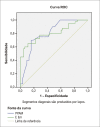The Relationship between Nocturnal Dipping Status, Morning Blood Pressure Surge, and Hospital Admissions in Patients with Systolic Heart Failure
- PMID: 37729291
- PMCID: PMC10519354
- DOI: 10.36660/abc.20220932
The Relationship between Nocturnal Dipping Status, Morning Blood Pressure Surge, and Hospital Admissions in Patients with Systolic Heart Failure
Abstract
Background: Hypertension is a known risk factor for developing heart failure. However, there is limited data to investigate the association between morning blood pressure surge (MBPS), dipping status, echocardiographic parameters, and hospital admissions in patients with systolic heart failure.
Objectives: To evaluate the relationship between morning blood pressure surge, non-dipper blood pressure pattern, echocardiographic parameters, and hospital admissions in patients with systolic heart failure.
Methods: We retrospectively analyzed data from 206 consecutive patients with hypertension and a left ventricular ejection fraction below 40%. We divided the patients into two groups according to 24-hour ambulatory blood pressure monitoring (ABPM) results: dippers (n=110) and non-dippers (n=96). Morning blood pressure surge was calculated. Echocardiographic findings and hospital admissions during follow-up were noted. Statistical significance was defined as p < 0.05.
Results: The study group comprised 206 patients with a male predominance and mean age of 63.5 ± 16.1 years. The non-dipper group had significantly more hospital admissions compared to dippers. There was a positive correlation between MBPS and left atrial volume index (r=0.331, p=0.001), the ratio between early mitral inflow velocity and flow propagation velocity (r= 0.326, p=0.001), and the ratio between early mitral inflow velocity and mitral annular early diastolic velocity (E/Em) (r= 0.314, p=0.001). Non-dipper BP, MBPS, and E/Em pattern were found to be independently associated with increased hospital admissions.
Conclusion: MBPS is associated with diastolic dysfunction and may be a sensitive predictor of hospital admission in patients with systolic heart failure.
Fundamento: A hipertensão é um fator de risco conhecido para o desenvolvimento de insuficiência cardíaca. No entanto, há dados limitados para investigar a associação entre pico de pressão arterial matinal (PPAM), estado dipper, parâmetros ecocardiográficos e internações hospitalares em pacientes com insuficiência cardíaca sistólica.
Objetivos: Avaliar a relação entre aumento matinal da pressão arterial, padrão de pressão arterial não-dipper, parâmetros ecocardiográficos e internações hospitalares em pacientes com insuficiência cardíaca sistólica.
Métodos: Analisamos retrospectivamente os dados de 206 pacientes consecutivos com hipertensão e fração de ejeção do ventrículo esquerdo abaixo de 40%. Dividimos os pacientes em dois grupos de acordo com os resultados da monitoramento ambulatorial da pressão arterial (MAPA) de 24 horas: dippers (n=110) e não-dippers (n=96). O aumento matinal da pressão arterial foi calculado. Achados ecocardiográficos e internações hospitalares durante o acompanhamento foram anotados. A significância estatística foi definida como p < 0,05.
Resultados: O grupo de estudo foi composto por 206 pacientes com predominância do sexo masculino e idade média de 63,5 ± 16,1 anos. O grupo não-dipper teve significativamente mais internações hospitalares em comparação com os dippers. Houve correlação positiva entre PPAM e índice de volume do átrio esquerdo (r=0,331, p=0,001), relação entre velocidade de influxo mitral precoce e velocidade de propagação do fluxo (r= 0,326, p=0,001) e relação entre influxo mitral precoce velocidade e velocidade diastólica inicial do anel mitral (E/Em) (r= 0,314, p=0,001). Verificou-se que a PA não-dipper, PPAM e o padrão E/Em estão independentemente associados ao aumento das admissões hospitalares.
Conclusão: O PPAM está associado à disfunção diastólica e pode ser um preditor sensível de internação hospitalar em pacientes com insuficiência cardíaca sistólica.
Figures




Similar articles
-
The relationship between morning blood pressure surge and asymptomatic episodes of paroxysmal atrial fibrillation in patients with systemic arterial hypertension.Turk J Med Sci. 2022 Dec;52(6):1906-1916. doi: 10.55730/1300-0144.5538. Epub 2022 Dec 21. Turk J Med Sci. 2022. PMID: 36945988 Free PMC article.
-
Nocturnal dipping status and the association of morning blood pressure surge with subclinical target organ damage in untreated hypertensives.J Clin Hypertens (Greenwich). 2019 Sep;21(9):1286-1294. doi: 10.1111/jch.13641. Epub 2019 Aug 3. J Clin Hypertens (Greenwich). 2019. PMID: 31376230 Free PMC article.
-
Ambulatory 24-hour blood pressure monitoring: correlation between blood pressure variability and left ventricular hypertrophy in untreated hypertensive patients.G Ital Cardiol. 1998 Jan;28(1):38-44. G Ital Cardiol. 1998. PMID: 9493044
-
[Blood pressure variation and cardiovascular risk in hypertension].Nihon Rinsho. 2004 Nov;62(11):2145-56. Nihon Rinsho. 2004. PMID: 15552901 Review. Japanese.
-
Research and Development of Information and Communication Technology-based Home Blood Pressure Monitoring from Morning to Nocturnal Hypertension.Ann Glob Health. 2016 Mar-Apr;82(2):254-73. doi: 10.1016/j.aogh.2016.02.004. Ann Glob Health. 2016. PMID: 27372530 Review.
References
-
- Fox KM, Mulcahy DA. Circadian Rhythms in Cardiovascular Function. Postgrad Med J. 1991;67(Suppl 3):S33–S36. - PubMed
MeSH terms
LinkOut - more resources
Full Text Sources
Medical

